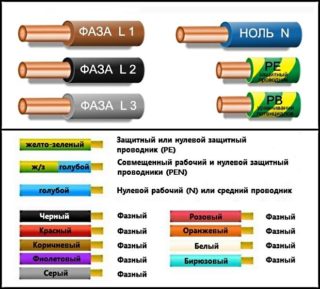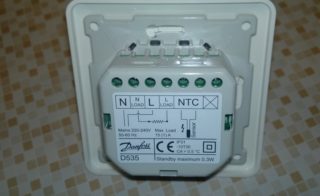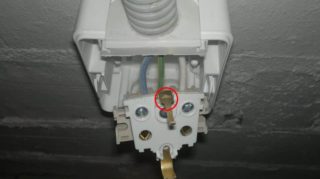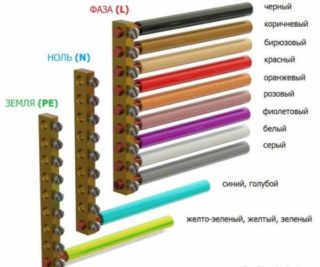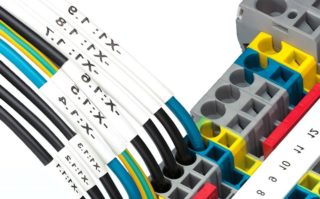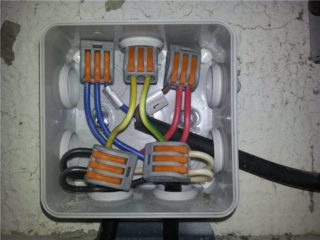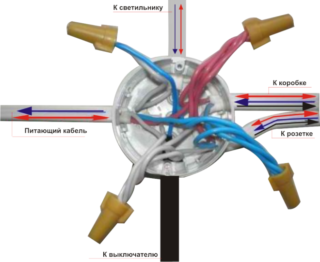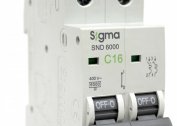With the independent connection of electrical equipment - fixtures, ventilation, machine, users can find the lettering of the terminals. L, N in an electrician is the phase and ground to which the corresponding cables are routed.
Wire lettering
For domestic and industrial power lines, insulated wires with internal conductive wires are used. Products differ depending on the color of the insulation coating and labeling. The designation of phase and zero in an electrician speeds up repair and installation work.
Cable marking in electrical installations under voltage up to 1000 V is regulated by GOST R 50462-2009:
- in clause 6. 2.1 it is indicated that the neutral conductor is marked as N;
- clause 6.2.2. states that the ground wire is PE;
- in paragraph 6.2.12 it is said that in an electrician L is a phase.
Understanding labeling simplifies installation work in utility, residential, and office buildings.
L - phase designation
In an alternating current network, a phase wire is energized. Translated from English, the word Line has the meaning of an active conductor, a line, therefore it is marked with the letter L. Phase conductors are necessarily covered with colored insulation, because, being in a bare state, they can cause burns, personal injury, fire or failure of various equipment.
N - letter character of zero
The sign of a zero or neutral working cable is N, from the abbreviation of the terms neutral or Null. When drawing up the circuit, the zero switching terminals in a single-phase or three-phase network are so marked.
The word "zero" is used only in the territory of the CIS countries, the core is called neutral throughout the world.
PE - grounding index
If the wiring is grounded, the letter marker PE is used. From English, the value of Protective Earthing is translated as a ground wire. Similarly, the terminals and contacts for switching with grounding zero will be indicated.
Conductor Insulation Coating
The colors of the grounding, phase and zero cables must be indicated in accordance with the requirements of the EMP. The document sets the color differences for grounding in the switchboard, as well as for zero and phase. Understanding the color designation of isolation eliminates the need for decoding of letter markers.
Ground wire color
 Since January 1, 2011, the European standard IEC 60446: 2007 has been in force on the territory of the Russian Federation. It noted that grounding has only yellow-green insulation. If a wiring diagram is compiled, the earth should be designated as PE.
Since January 1, 2011, the European standard IEC 60446: 2007 has been in force on the territory of the Russian Federation. It noted that grounding has only yellow-green insulation. If a wiring diagram is compiled, the earth should be designated as PE.
Grounding conductor is only in cables from 3 cores.
The PEN conductors used in old buildings combine earth and ground conductors. In this case, the insulation coating has a blue grounding color and yellow-green cambrics at the connection points and the ends of the wire. In some cases, reverse marking was used - the vanishing of yellow-green color with blue tips.
The ground and zero conductors of the PEN cables are thinner than phase wires.
The organization of protective grounding is a prerequisite for creating an electrical network in residential and industrial buildings. Its necessity is indicated in the PUE and GOST 18714-81. Standards state that zero ground should have the least resistance. In order not to get confused, use the color marking of the cables.
Color designation of zero working contacts
In order not to mix up where the phase is and where is zero, instead of the letters L and N they are guided by the colors of the cables. Electrical standards note that the neutral is blue, blue, blue-white, regardless of the number of cores.
Zero can be denoted by the Latin letter N, which in the diagram is read as minus. The reason for reading is the participation of zero in the circuit circuit.
Phase wire color
A phase is a live line that, if carelessly touched, can result in electric shock. Novice masters often have difficulty finding a cable. The phase is designated black, brown, cream, red, orange, pink, purple, gray and white.
The letter phase index is L. It is used where wires are not marked with color. When connecting the cable to several phases, a serial number is placed next to the letter L or the Latin letters A, B, C. The phase is also often marked as a plus.
The phase wire cannot be blue, blue, green, or yellow.
Why use color coding?
You can determine L and N in an electrician using an indicator screwdriver. You will need to touch the tip of the part of the product without an insulating coating. The glow of the indicator indicates the presence of a phase. If the LED does not light up, the core is zero.
The color designation reduces the time to find the right wire, troubleshooting. Knowing the colors of the conductors also eliminates the risks of current damage.
The nuances of manual color marking
Manual marking is used when wires of the same color are used in houses of old buildings. Before starting work, a diagram with the color values of the conductors is drawn up. During laying, you can mark current-carrying conductors:
- standard cambric;
- shrink cambric;
- insulating tape.
The rules allow the use of special kits for marking. Marker installation points for zero and phase are indicated in the EMP and GOST. These are the ends of the wire and the places of its connection to the bus.
The specifics of the marking of a two-wire wire
If you have already connected the cable to the network, you can use the indicator screwdriver. The difficulty of using the tool lies in the impossibility of determining several phases. They will need to be called with a multimeter. To prevent confusion, you can mark the electrical conductor with a color:
- select heat shrink tubes or electrical tape to indicate zero and phase;
- work with conductors not along the entire length, but only at the joints and joints.
The number of colors is determined by the scheme. The main thing when creating it is not to get confused, not to use yellow, green or blue markers for the phase. It can be marked in red or orange.
Three-wire marking
To search for phase, grounding and zero in a three-wire wire, it is advisable to use a multimeter. They put it on AC voltage and carefully touch the phases with the probes, then the remaining wires. Tester performance should be recorded and compared. In the phase-to-earth combination, the voltage will be less than in the phase-zero combination.
After clarifying the lines, you can mark. Understand the phase - L or N, the corresponding color will help. At zero, it will be blue or blue, at plus - any other.
Five-wire system marking procedure
Wiring from a three-phase network is carried out only by a five-core cable. Three conductors will be phase, one neutral, one protective earth. Color coding is applied according to regulatory requirements. For protection, a yellow-green braid is used, for zero - blue or blue, for a phase - from the list of allowed shades.
How to mark aligned wires
To simplify the wiring process, cables with two or four cores are used.The defense line here is connected to the neutral. The letter index of the wire is PEN, where PE stands for ground and N stands for neutral conductor.
According to GOST, special color marking is used. The combined cable will be yellow-green in length, and the ends and connection points will be blue.
Highlight the main points of the problem areas with cambric or electrical tape.
Wiring colors as a way to speed up installation
Prior to GOST R 50462-2009, the cables were marked in white or black. The phase and zero were determined when the control disconnected at the moment of power supply.
The use of color markers simplifies repair work, ensures their safety and convenience. Focusing on the shade of cables, the master will not spend much time to conduct electricity in a house or apartment.
Consider the meaning of color marking can be an example of a lamp. If the lamp changes, and the zero and phase are mixed up, there are risks of injury or death from electric shock. When the designation L and N is made in color in an electrician, the phase goes to the switch, and zero to the light source. The voltage is neutralized, and you can even touch the light on.
Installation wiring requirements
From the distribution box, a copper wire with one or two conductors is pulled to the switch. The number of cores depends on the number of instrument keys. A phase should break, not a zero. In the process, it is allowed to use a white conductor for powering, making a mark on the diagram.
The socket is connected taking into account polarity. The working zero will be on the left, the phase on the right side. Grounding is located in the middle of the device and clamped by a terminal.
If you have two cables of the same color, you can find the phase and neutral using the control, indicator screwdriver, multimeter.
On the wiring diagram, it is worth indicating what L and N mean, but several are used in the electrics. On the single-line, the power part is displayed - the type of power, the number of phases per consumer. It is advisable to draw one serif on a single-phase network, three on a three-phase network and indicate the wires in color. Switching and protective equipment is marked with special symbols.
Correct marking and color marking of wires ensures the quality of installation and maintenance of the line. The designation according to international requirements allows electricians and home craftsmen to navigate in the circuit.
